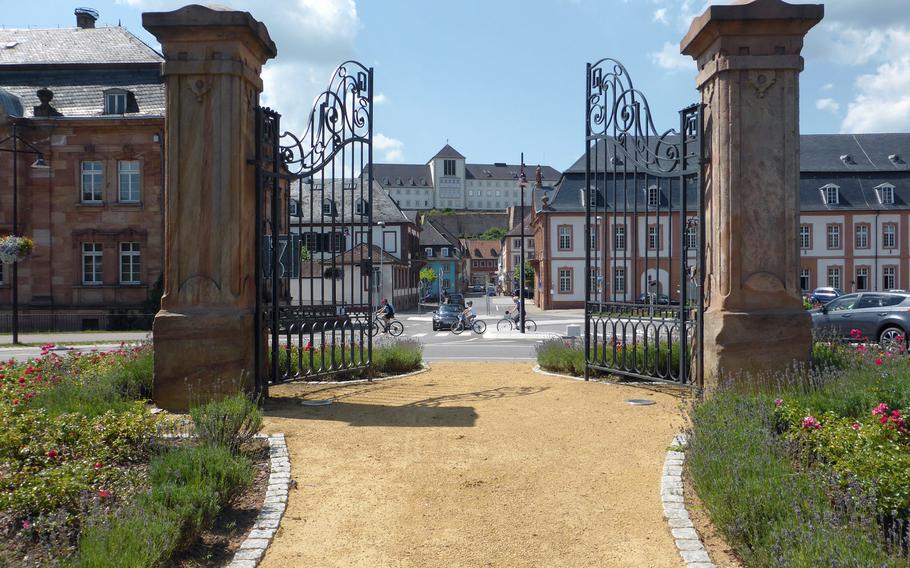
Standing in the middle of a traffic circle, this open gate welcomes visitors to Blieskastel, a town in Germany's Saarland state. (Michael Abrams/Stars and Stripes)
If you are looking for a nice place to go for a day, without having to drive too far, we have just the place for you.
Not far from Kaiserslautern, Ramstein or Baumholder is the town of Blieskastel.
It first came to our attention while driving to France on Autobahn A6. There was one of those brown signs that point out places of interest, and it read “Barockstadt Blieskastel.” So one sunny summer morning we headed out to see how much baroque Blieskastel had to offer.
Turns out, quite a bit: a church, a small palace, a town hall and a long row of houses all built in baroque style, although perhaps not quite as ornate as you see in some places, such as France, perhaps.
But Blieskastel, as we found out, has even more going for it: a restaurant/cafe-ringed market square, a pilgrimage chapel with a remarkable statue, other nooks and crannies with a variety of architecture and a 4,000-year-old monolith standing in a field above the town.
Driving into Blieskastel, the first thing you notice is an open gate sitting in the middle of a very busy traffic circle. It is sort of an open-hearted welcome to the town, but the only way to actually get up close to it by foot is by dodging cars going around the circle. It’s best just to park the car in one of the nearby lots and walk into town.
Its center is the Marktplatz with its Napoleon Fountain. Because a snake wraps around and protrudes from the fountain, spouting water from its mouth, it is also known as the Schlangen-brunnen, or Snake Fountain.
From here, follow the pedestrian signs to the Heilig-Kreuz-Kapelle. After a steep climb, you come to the 17th-century chapel that has been a place of pilgrimage over the centuries, interrupted only by the French Revolution, when French soldiers used it as an ammunition dump.
Inside, behind the altar, is the “Unsere Liebe Frau mit den Pfeilen,” or “Our Dear Lady with the Arrows,” icon. According to legend, marauding soldiers shot arrows into the wood carving and blood ran from its wounds. A countess of Blieskastel’s eye disease was cured when she rubbed the blood in her eyes.
There are many religious statues outside the chapel and in the nearby gardens.
Walk back into town and follow signs to the Schlösschen, or Little Palace. On your way, you pass a row of baroque buildings lining the street. The Schlösschen, the last in the row, was built in the late 18th century and is one of the best examples of the town’s baroque architecture. Today it is used as a school.
Across the street is the baroque Schlosskirche. Construction began in 1776 and final touches were made in 1781. The interior has been recently renovated.
Behind it is the Renaissance Lange Bau, the last remnant of the city’s palace. Known as the Orangerie and built in the late 17th century, it is used today for concerts and exhibitions. Its garden is a relaxing place to rest weary feet.
Then follow the signs to the Gollenstein, about a mile hike.
The 4,000-year-old monolith is one of Germany’s oldest cultural monuments.
It was dismantled in 1939 because it was considered a possible marker for French artillery across the nearby border. Unfortunately, it broke in four pieces. It was re-erected in 1951, using concrete to hold it together.
If you didn’t have lunch in town, consider a picnic on this ancient site.
Blieskastel, Germany DIRECTIONS Take Autobahn A6 toward Saarbrücken, then A8 toward Zweibrücken, exiting at the Einöd/Blieskastel exit. Follow highway B423 to Blieskastel. From Kaiserslautern, it is about 37 miles; from Baumholder, about 45 miles.
TIMES Visit anytime, but it is more fun when the weather is good and you can sit outside.
COSTS Parking in the big lots on the edge of town is free.
FOOD There are plenty of restaurants and cafes in all price classes.
INFORMATION See www.blieskastel.de (German only).